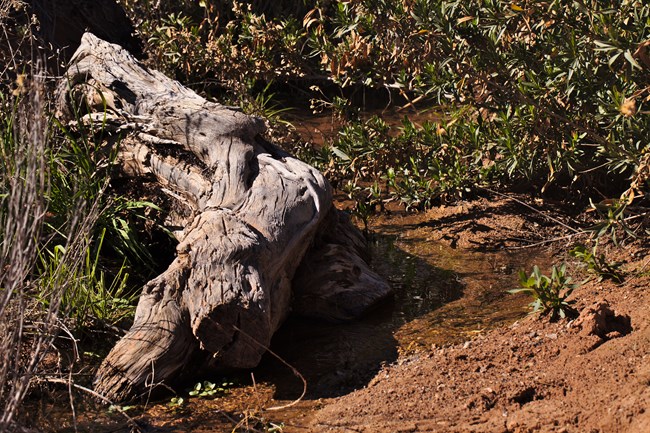
NPS/ Kenneth Ingham In the late 1970’s Pakoon Springs had seen many seasons. Several different owners, including Native Americans, homesteaders, and ranchers laid their claims on the area, but none made their claim quite like a self-proclaimed “weekend cowboy” by the name of Charles “Chuck” Simmons. One of the first interesting critters to be introduced to Pakoon Springs was Clem the alligator. In the late 1980’s Clem was transported over from Georgia by a few friends of Chuck’s as a gift to the rancher. Chuck, not knowing exactly what to do with an alligator, sent him into the pond and wished him the best. Clem kept to himself most days, barring a few exceptions when he was lured out with 7 whole chickens or children swimming in his pond. Chuck even thought at one point he had been scooped up by a helicopter using the water in the pond to put out a nearby wildfire. Clem, however, was eventually found in 2003 by BLM workers, but not before making true the wild tale of the alligator on the Arizona Strip. Chuck also raised about 500 ostriches at Pakoon at one time. Running cattle became a difficult process—it was more work than it was worth. In the 1980’s ostrich meat became a new craze, and Chuck decided he would have a go at the booming industry. Unfortunately, the demand for ostriches in the U.S. plummeted quickly, and Chuck had more ostriches than he knew how to deal with. He had to give most of them away, because if he turned them loose he wasn’t sure how the Bureau of Land Management would react to 500 ostriches roaming the Mojave Desert! In addition to an alligator and ostriches, Chuck and his family also raised pigs and burros on the ranch. In an interview, Chuck once told the story of a man who offered by buy the pigs from his father-in-law, who was living on the property at the time. The man arrived at Pakoon, only to find no pigs, and nobody to sell them. After waiting a few hours, Chuck’s father-in-law arrived, introduced himself to the man, and then promptly fired his shotgun in the air three times. Faster than you could say Jack Robinson, the pigs all arrived eagerly at their pens. After a puzzled look from the man, Chuck’s father-in-law explained: “They think it is chow time. I have been feeding them burros!” Burros, while also serving as food for the hogs, also became some beloved, and pestering pets to the family. One year they rescued a crippled burro that couldn’t walk. After nursing it back to health, the burro stuck around as she had grown quite close to the family. But she soon became somewhat of a nuisance. Anyone who didn’t feed her at the time of her liking was knocked clean over until her bucket was full of feed. Pakoon Springs is a very different place now that there are no ostriches, alligators, or pigs, and the burros that remain are now wild. Today, the springs are part of a comprehensive rehabilitation project to restore the area to its natural habitat. Desert springs are an essential component of life on the Arizona Strip, as they are often the only sources of natural groundwater, and play important roles in their delicate ecosystems. One disruption of these springs can have severe consequences. Because the springs at Pakoon are so important to the area, Grand Canyon Parashant NM worked to restore the area to its natural habitat. The springs are slowly taking on their natural form, but not without remembering its wild and wonderful past, full of ostriches, alligators, and pigs. |
Last updated: April 14, 2023
